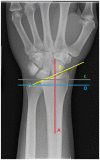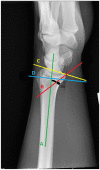Radiographic Predictors of Delayed Carpal Tunnel Syndrome After Distal Radius Fracture in the Elderly
- PMID: 35815368
- PMCID: PMC9274875
- DOI: 10.1177/1558944720963876
Radiographic Predictors of Delayed Carpal Tunnel Syndrome After Distal Radius Fracture in the Elderly
Abstract
Background: Delayed-onset carpal tunnel syndrome (DCTS) can develop weeks and months after distal radius fracture (DRFx). A better understanding of the risk factors of DCTS can guide surgeon's decision making regarding the management of DRFx and also provides another discussion point to be had with elderly patients when discussing outcomes of nonoperative management.
Methods: We reviewed 216 nonoperatively managed DRFx between June 2015 and January 2019 at a single level 1 trauma center and senior author's office. We identified 26 patients who developed DCTS at a minimum of 6 weeks after DRFx, which constituted our case group. The remaining 190 patients served as the control group (non-carpal tunnel syndrome [CTS]). Differences between case and control group were evaluated through univariate and multivariate analyses.
Results: The prevalence of DCTS among nonoperatively managed DRFx was 12%. In univariate analysis, volar tilt (VT) and teardrop angle (TDA) were significant independent predictors of development of DCTS. Multivariate logistic regression analysis determined that the odds of developing CTS increased by 12% and 24% for each degree of decrease in VT and TDA, respectively. No other significant risk factors were identified.
Conclusions: Decreasing VT and TDA are the most significant risk factors associated with DCTS in nonoperatively managed DRFx. These are simple and reliable radiographic measurements that provide significant prognostic value. These parameters can be used to guide surgeon decision making regarding management of DRFx in the elderly while aiding patient expectations and outcomes following nonoperative management of DRFx.
Keywords: basic science; carpal tunnel syndrome; diagnosis; distal radius; evaluation; fracture/dislocation; nerve; nerve compression; research and health outcomes; trauma; wrist.
Conflict of interest statement
Figures



Similar articles
-
Is Carpal Tunnel Release Necessary in High-Energy Distal Fractures of the Radius?Cureus. 2024 Feb 1;16(2):e53404. doi: 10.7759/cureus.53404. eCollection 2024 Feb. Cureus. 2024. PMID: 38435175 Free PMC article.
-
Correlation between delayed carpal tunnel syndrome and carpal malalignment after distal radial fracture.J Orthop Surg Res. 2023 May 17;18(1):365. doi: 10.1186/s13018-023-03844-z. J Orthop Surg Res. 2023. PMID: 37193988 Free PMC article.
-
Carpal Malalignment as a Predictor of Delayed Carpal Tunnel Syndrome after Colles' Fracture.Plast Reconstr Surg Glob Open. 2019 Mar 13;7(3):e2165. doi: 10.1097/GOX.0000000000002165. eCollection 2019 Mar. Plast Reconstr Surg Glob Open. 2019. PMID: 31044126 Free PMC article.
-
Carpal Tunnel Syndrome and Distal Radius Fractures.Hand Clin. 2018 Feb;34(1):27-32. doi: 10.1016/j.hcl.2017.09.003. Hand Clin. 2018. PMID: 29169594 Review.
-
Carpal tunnel syndrome after distal radius fracture.Orthop Clin North Am. 2012 Oct;43(4):521-7. doi: 10.1016/j.ocl.2012.07.021. Epub 2012 Sep 4. Orthop Clin North Am. 2012. PMID: 23026468 Review.
Cited by
-
Is Carpal Tunnel Release Necessary in High-Energy Distal Fractures of the Radius?Cureus. 2024 Feb 1;16(2):e53404. doi: 10.7759/cureus.53404. eCollection 2024 Feb. Cureus. 2024. PMID: 38435175 Free PMC article.
-
Correlation between delayed carpal tunnel syndrome and carpal malalignment after distal radial fracture.J Orthop Surg Res. 2023 May 17;18(1):365. doi: 10.1186/s13018-023-03844-z. J Orthop Surg Res. 2023. PMID: 37193988 Free PMC article.
References
-
- Wolfe SW, Pederson WC, Kozin SH, et al.. Distal Radius Fractures: Green’s Operative Hand Surgery, 2-Volume Set. Vol. 1. 7th ed. Philadelphia, PA: Elsevier Health Sciences Division; 2016:516-587.
-
- Earp BE, Mora AN, Floyd WE, et al.. Predictors of acute carpal tunnel syndrome following ORIF of distal radius fractures: a matched case–control study. J Hand Surg Glob On. 2019;1(1):6-9. doi:10.1016/j.jhsg.2018.10.002. - DOI
Publication types
MeSH terms
LinkOut - more resources
Full Text Sources
Medical
Research Materials

